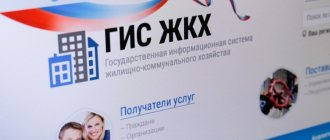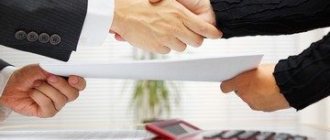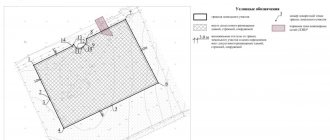Maintenance costs
Who do we pay?
Management company. In our case, this is LLC “UK Moy Gorod”.
What are we paying for?
Current content: The most extensive and variable tariff. This includes services (preparation for winter, maintenance of elevators and meters, etc.), janitor work, snow removal, deratization (extermination of rats or mice), garbage removal, elevator maintenance, expenses for routine repairs and a long list of all kinds of household goods. The money we pay will be used to purchase materials and salaries for the management company’s specialists.
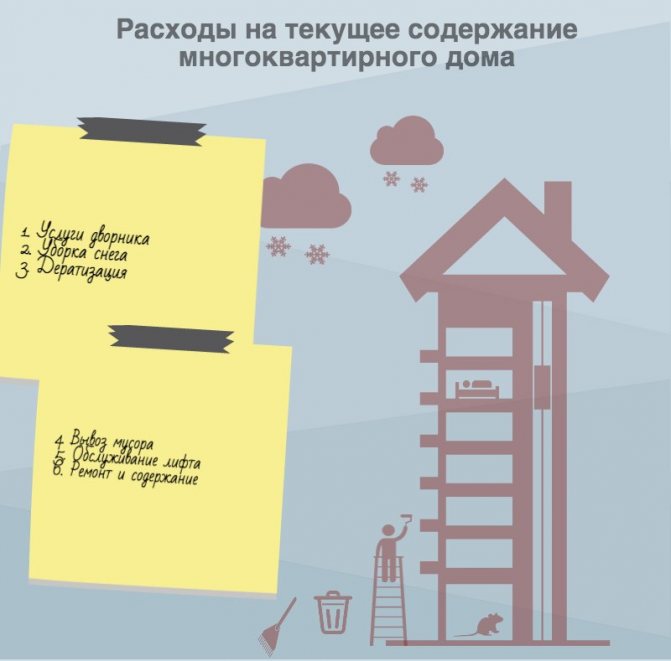
How much do we pay?
Ideally, the general meeting of residents should determine which items will be indicated in this tariff. For example, they may decide not to spend more money on exterminating rodents (they’ve killed them all for several years now), but instead pay the janitor more to sweep not once a day, but three times.
But, as Oleg Ilyasov said, in many buildings, meetings of residents are generally a rare thing, and it is impossible to expect clear decisions from them. Such houses are charged at a rate approved by the city council of people's deputies - according to the social norm, but they also do not receive any services above this norm. As we can see from our “payment”, in “UK My City” this fee is 18.67 rubles per square meter. We simply multiply this amount by the number of square meters and get the real cost of “current maintenance”.
Lines 2,3
What is aur in a housing and communal services receipt?
/ / 19. AUR – administrative and management expenses of the management organization.
They consist of expenses for the salary of the manager, management of the management organization, accounting, payment for servicing the current account, office expenses, telephone payments, maintenance of the premises occupied by the manager, furniture installed in it, printing of invoices, concluding contracts with suppliers, monitoring the implementation of concluded contracts, etc.28. Cold water, hot water, electricity for sod.OI - communal resources (cold water, hot water, electricity) spent on the maintenance of common property.
(HVS - costs for maintaining common areas, flushing the system, watering lawns and sidewalks, emergency leaks, washing glazing; DHW - for maintaining common areas, losses of thermal energy during circulation, flushing the system, emergency leaks; Electrical - lighting MOP and external lighting of the house, the operation of low-current systems (APPP, ROM, ODS), the operation of elevators, pumps, etc. It should be noted that there is no single form of receipt for housing and communal services, mandatory for all. In different regions, cities, even houses, management and the supply of utility resources occurs in different ways.Therefore, the payment slip may differ in appearance, shape, and color.
It may consist of two parts: a notice and a receipt, or it may take the form of a single document. What is included in the ODN according to current legislation? In fact, we are talking about the costs of maintaining the common property of the house.
And it includes cleaning of entrances, their lighting and heating, maintenance of elevators and other measures to maintain its normal condition. For the most part, the basis of Rospotrebnadzor’s regulations is clause 69 of Rules No. 354.
This paragraph talks about the data that must be included in receipts for housing and communal services. In accordance with the agreement on the provision of corporate governance, other information can be placed on payment cards, however, advertising information is not included in any of the permitted categories.
If a receipt for housing and communal services is lost, it can be restored through a service provider or resource.
When paying for housing and communal services at a financial institution, the payer needs to obtain information from the banking system about previously made contributions. Ideally, of course, you shouldn’t lose payment documents.
It is not always possible to restore them on time and quickly. After installing the application, you need to point at the QR code of the receipt, then confirm your payment details and enter your personal data. The last step: select a bank card and confirm payment.
kvartplata.beeline.ru is a service of the cellular operator Beeline. On the site you can pay for housing and communal services without commission, but under one condition - you need to be a Beeline subscriber, and also have a certain amount on your phone account.
This option is the oldest, and for a long period was the only way to pay utilities.
All that is required is to come to any bank branch, stand in line if necessary and pay for the services.
Decoding of utility bills for housing and communal services, which is included in the rent receipt
02/27/2020 Every month all tenants (owners) of residential premises must pay bills.
It should be noted that there is no single form of receipt for housing and communal services that is mandatory for everyone.
In different regions, cities, even houses, the management and supply of utility resources occurs differently. Therefore, the payment card may differ in appearance, shape, and color. It may consist of two parts: a notice and a receipt, or it may take the form of a single document.
Officially by Order of the Ministry of Construction No. 924/pr. dated December 29, 2014, only an approximate form of rent receipts was approved.
However, this document is only advisory in nature, its use is not mandatory. Due to changes in housing legislation that came into force at the beginning of this year, this sample model has also undergone some additions. But, in general, the structure of the document remains the same.
Next, we will figure out what is included in this document, what is the basis for payment on the receipt. In fact, any receipt should include the following information:
- about the payer and recipient of payment for housing and communal services (full name, name of organization, TIN, bank details, personal account number);
- calculation of payments for each type of services provided;
- reference Information.
- information about the residential premises (area of the apartment, the house as a whole, address, number of residents);
Despite possible differences in appearance, in general, any payment card consists of several sections:
- overhaul fee;
- details for transferring the fee;
- calculation of housing maintenance fees;
- reference information (notice).
- calculation of utility bills;
- information about the payer and recipient;
- information about recalculations;
The text of any receipt contains many different abbreviations and numbers.
They are quite understandable to workers in the housing and communal services sector. However, owners and tenants have a question about how to read the housing and communal services receipt. Moreover, different organizations may use their own abbreviations.
At the same time, there is a certain generally accepted abbreviation for payment for the maintenance of apartments and utility bills (HVS, DHW, DHW ODN, HVS ODN, ODN, VDGO, etc.). Most of the data on the receipt is presented in table form.
Each line indicates a separate type of service, including its name, tariff, standard, volume consumed, payment amount. Next, let's look at how each of them is deciphered. An abbreviation such as ODN is often found on receipts.
Rent aur what is it
» » . Bank services - 3%, printing receipts - 9 rubles These are the exact wording of the services that the HOA offers to pay for, as well as the inflated tariff for AUR compared to the city one. Perhaps this has already been discussed.
Thus, payment for residential premises and utilities includes: 1) payment for the maintenance and repair of residential premises, including a) payment for services and work on managing an apartment building, b) maintenance of common property, c) routine repairs of common property ; 2) contribution for major repairs; 3) payment for utilities; 4) payment for the use of residential premises (rental fee) - for non-owners of residential premises.
This list is exhaustive, that is, all other names of services are only components of the above services.
Payment for services and work for managing apartment buildings is AUR (administrative and management expenses), or AHR (administrative and management expenses), or expenses for AUP (administrative and managerial personnel) in the estimate of income and expenses and receipts.
As you can see, “AUR” (“AHR”, “expenses for AUP”) and “common property of apartment buildings” are separate lines in the article “and repairs of residential premises” of the estimate of income and expenses of housing cooperatives.
Housing cooperatives and homeowners' associations have the right to develop financial reporting forms independently. Of the documents regulating the organization of accounting in housing cooperatives, there is only Letter of the Ministry of Finance of Russia dated October 29, 1993 N 118
“On the reflection in accounting of transactions in housing and communal services”
. However, this letter does not say anything about what expenses the calculation of salaries for the chairman relates to.
Therefore, here it is necessary to be guided by the documents recommended for keeping records in other non-profit organizations. Thus, there are Recommendations on the organization of financial and accounting for homeowners’ associations, approved. By order of the Gosstroy of Russia dated July 14, 1997 N 17-45.
In accordance with them, administrative and management expenses are the salaries of administrative and management personnel with accruals, overhead and other expenses.
Administrative and management expenses may include: - wage fund with accruals (contributions to the Pension Fund, Mandatory Health Insurance Fund, Social Insurance Fund, Employment Fund, transport tax); — maintenance of the office of the Board of the Partnership (heating, hot and cold water supply, lighting, telephone payment, etc.); — training of management personnel (training, acquisition of regulatory documents and special literature);
Aur on the receipt what is it
Source: https://indsn.ru/chto-takoe-aur-v-kvitancii-zhkh-96694/
Hot water

Who do we pay?
The energy supplier is Teploenergo OJSC.
What are we paying for?
For hot water in the bathrooms and kitchen, and also for “general household needs.” Funds paid by residents are used for the maintenance and repair of boilers and communications, the purchase of coal and fuels and lubricants, as well as for employee salaries.
How much do we pay?
In the second line, a system of two tariffs already begins to operate - “according to the social norm and above the social norm.” To pay for hot water, there is a uniform standard for the entire city - 3.37 m3 per person per month. In our “payment” we are talking about an apartment with two tenants. This means the standard is 6.74 m3. In December they used 6 m3 per couple. We met the standard, which means we count according to the social norm. We simply multiply the tariff by the cubic meters spent.
25.49 x 6 = 152.94 rubles
But let's make it more difficult. Let's imagine that the residents of this apartment took a bath very often and exceeded the norm, spending, for example, 8 m3 of hot water. In this case we think like this:
• 8 – 6.74 = 1.26 m3. This is excessive consumption of hot water.
• 6.74 x 25.49 rubles (social tariff) = 171.80 rubles
• 1.26 x 46.6 rubles (tariff “above the social norm”) = 58.71 rubles
• We add up the resulting results: 171.80 + 58.71 = 230.51 rubles. This is the amount you have to pay for hot water.
For general house needs, payment is fixed, according to the same standard. Our residents pay this 4.87 rubles every month.
“To be honest, this is a generally difficult position to explain. It is prescribed by law, but now the issue is being developed to make amendments and remove the ODN for water altogether. But until the amendments are made, we are accruing one fixed income tax – as stated in the law,”
— explained
Oleg Ilyasov
.
Line 4
How to decipher a utility bill
A standard receipt for housing and communal services looks like a small white rectangle of paper with a lot of abbreviations, abbreviations, dates, consumption rates, subscriber data and meter readings printed on it.
The personal account is located at the very beginning of the receipt. As a rule, citizens are interested in the final figure of the accrued fee and an indication of whether there is a debt for the service. This data is indicated at the top of the payment in its detachable part, and is also duplicated in the main segment of the document along with their detailed decoding for each service.
Dear readers! The article talks about typical ways to resolve legal issues, but each case is individual. If you want to find out how to solve your particular problem , contact a consultant:
8 (800) 700 95 53
APPLICATIONS AND CALLS ARE ACCEPTED 24/7 and 7 days a week.
It's fast and FREE !
Rules of use or other minor information are sometimes printed on the back of the receipt. The document is not sealed or signed by authorized persons.
As of today, almost all receipts for housing and communal services are a single payment document that includes all utilities. This became possible thanks to the introduction of the UIRC system (unified information and settlement centers).
Separate payments can also be used, for example, in some regions separate receipts are issued for payment for electricity and gas.
The structure of the document, using the example of a general payment for the entire housing and communal services complex, includes the following data (in order from top to bottom):
| Part of the receipt | What it contains |
| Notice or invoice notice (tear-off part) | It is torn off by the cashier upon payment and remains with the payer with confirmation of the deposit of money. The excerpt states the following:
|
| Receipt or invoice | This part remains with the cashier when the payment is made. The same data is duplicated, but in this segment there is no longer a barcode or QR code, and additionally more extensive information is indicated (room area, number of people):
|
| Table of charges separately for each service | This is a structural part of the receipt, but it requires separate consideration, since it contains the name of each service, the actual and estimated cost, and units of measurement. Using this data, the user can independently check the accuracy of the accrual. It states the following:
|
The types of payments in the table require separate explanations:
| Housing and communal services group | What is included in the group and definition of abbreviations |
| Housing |
|
| Utilities |
|
| Others |
|
| In some receipts in 2020, a new line “MSW management” appeared - this is the removal of municipal solid waste, that is, garbage. Previously, payment for this was paid to the housing office account as part of general house needs. Now it has been developed into a separate service. | |
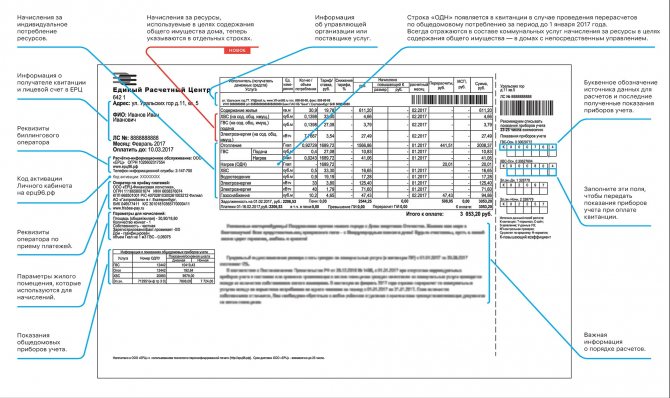
Housing and communal services receipt in detail
Water
If there is a meter in the apartment, the payment for hot and cold water is calculated according to its readings and the established tariffs per unit of resource. Tariff is the price for one cubic meter of water established by regulations of regional authorities. This applies to both cold and hot water.
Read How long is a passport valid after turning 45 in Russia?
Formula and calculation example:
| Formula | Calculation example |
| According to the counter indicators | |
| Water supply = metered volume x tariff | Calculation procedure:
|
| Without counter | |
| Water supply = count people x consumption standard x tariff | Calculation procedure:
|
| The fee for hot water is calculated in the same way. | |
Do not confuse water supply, which refers only to water as a resource, and sanitation, which includes the following:
- transportation of water by sewerage;
- infrastructure maintenance (pipes, sewerage);
- cleaning;
- recycling;
- drainage.
For drainage, the calculation has its own formulas:
| Formula | Calculus |
| By meter | |
| Multiply the amount of water on the meter for the estimated time by the sewerage tariffs. Drainage = (volume of cold water x tariff) + (volume of hot water x tariff) | Calculation procedure:
Example:
|
| Without counter | |
| Based on water consumption standards. | They are installed annually, you can check them on the websites of the local administration, as they are published there. The standards are not the same for all regions. |
In apartment buildings there is a feature regarding drainage: calculation is carried out according to the indicators of the house meter, and not for each apartment separately. If there is no general house control device, then the management company (management company) makes a calculation using current consumption standards.
The tenant has the right to equip his apartment with a separate control device (water meter). He must inform the management company about this, which will register it, check whether it works correctly, seal it and issue a permit. In this case, payments for water supply and sanitation will be recalculated.

How to pay utilities
Heating
| Calculation rules | Description and formula |
| There are no meters in the apartment | |
| Heating in a house without a meter is paid for during the heating season. The fee takes into account the following:
| By multiplying the tariff by the area of residential premises (total), the volume of heat used per month is obtained. It is multiplied by the tariff and the amount that needs to be paid for the past month is obtained. Formula: Heating = norm x area sq. x tariff Example:
|
| According to the common house meter | |
| The amount is formed according to the readings of the control device, taking into account the tariff. | Heating = volume according to the meter x (sq. area / mkd area) x tariff Example input data:
Calculation: 72 (63 / 5100) x 1601.35 = 1424.26 rubles. |
| There is both a common house meter and an individual meter in each apartment | |
| The indicators of two devices are taken into account using a special formula and multiplied by the tariff. | Formula: Heating = (volume by quarterly account. + volume by general building account. x (square area / house area)) x tariff Example:
Calculation: (2+(140-100-15) x 51/8100) x 1601.35 = 3217.73 rub. |

How to get compensation for an error in a housing and communal services payment
Electricity
In most cases, residents pay for electricity using a separate receipt. The total receipt includes only resource consumption for general household needs. In the payment slip this is indicated by the abbreviation “El. zn. MOP" (the latter abbreviation means "Public Areas").
The amount is calculated by dividing the meter indicator for the billing period, which records energy consumption in common areas of the building, by the number of apartments and multiplying the result by the tariff.
In some regions, starting from 2020, fees for individual apartment electricity meters began to be included in unified payment documents. Calculation of payments for an apartment meter is carried out as follows: the indicator of the device for the billing period (month) is multiplied by the tariff established by local service providers (for example, MosOblEnergo) per unit of resource (kW /d/, kW /n/, that is, separately per night /day if a split tariff is used).
Gas
The rules for the provision of gas supply services are regulated by Government Decree No. 354 of 05/06/2011.
Decree of the Government of the Russian Federation dated 06.05.2011 N 354
The features of the calculation are:
| Presence or absence of a counter | Calculation formula and examples |
| There is an individual metering device (clause 42 of Resolution No. 354) | The meter reading for the billing period is multiplied by the tariff established in the region. Example:
|
| There are no meters in the apartment | Formula: Г = [(sq.m x normal heating consumption)+(number of people x normal for cooking)+(number of people x normal for heating water)] x tariff Some standards are not included in the calculation, for example, the variable “norm. for preheating water" is used only when there is no central hot water supply in the house. In MCD, as a rule, only the “norm” variable is used. for cooking food." An example of this option is the following:
|
Heating

Who do we pay?
JSC "Teploenergo"
What are we paying for?
For the hot water that runs through pipes and radiators and warms us from September to May.
How much do we pay?
As in the case of hot water, heating fees are also charged at two tariffs. But, as Oleg Ilyasov
, here the fee is calculated differently - for each heated square meter. And the size of the social norm depends on the ratio of the area of the apartment and the number of residents.
“An area that is above the social norm is a slightly different tariff. 33 square meters is the social norm for one person. If there are two, then 42 squares. If there is an excess, then each square is charged at a rate “above the social norm”,
— said
Oleg Ilyasov
.
It should be taken into account that in the city of Kemerovo there are two types of houses: some have communal heat meters installed (this is approximately 90% of apartment buildings), while progress has not yet reached the rest. The former pay for heating only from September to May (0.28 Gcal/m2), the latter pay for the whole year (0.14 Gcal/m2). However, the calculation principle is the same in both cases.
Calculating payment for heating is the most complex mathematical operation in your “payment bill”. There are a lot of decimal fractions here, you have to multiply by zero integers and God knows how many thousandths, but if you decide to be a zealous owner, then please comply. However, in reality, everything is not so scary - the calculator will help you.
So, we are considering a payment for an apartment with an area of 70.8 m2, in which two people live. That is, in our case, 28.8 m2 must be paid at a more expensive, “supersocial” tariff. There is a common house meter, so the standard is 0.028 Gcal/m2.
The formula is as follows: number of Gcal/m2 x tariff x area.
0.028 Gcal/m2 x 595.14 rub. x 42 m2 = 710.84 rub. This is the price for 42 square meters according to the social tariff. Now we are carrying out the same operation for the remaining 28.8 m2 at a tariff above the social norm.
0.028 Gcal/m2 x 746.24 rub. x 28.8 m2 = 611.18 rubles (28.8 square meters at a rate above the social norm)
We add up the results:
710.84 + 611.18 = 1322.02 rubles – the total amount for heating the apartment in January.
By the way, there are no “common house needs” for heating. The calculations take into account the total cubic capacity of the house, which means that what you paid should be enough to heat the entrance, basement and attic.
Lines 5, 6, 7
We do everything according to the law
In order to collect fees for additional services not specified in Article 154 of the RF Housing Code, the management organization must make appropriate changes to the trust management agreement, which stipulate the name, quantity, tasks or purposes of the service, and its cost. And only when each of the owners signs this agreement, the service is provided.
That is, if you are against the provision of an additional service, you do not sign the contract or amendments to it, and below write the reason for not agreeing. It must be borne in mind that the Housing Code of the Russian Federation directly states that the issue of providing additional services is not within the competence of the general meeting of owners of apartments in apartment buildings, therefore each owner decides this issue for himself: whether he needs the service or not.
Let's go back to the intercom
You also need to understand that if you refuse to sign an agreement for the provision of an additional service, then 2 scenarios will arise:
- Regardless of your refusal, you will be charged for providing a service you do not need. You can safely go to complain - the action of the management organization violates the law.
- You will not be charged any payment, just like others who refuse, and all costs will be evenly distributed among the other owners of apartments in your building. How you look your neighbors in the eyes is your business.
If you installed an intercom in your apartment, you will have to pay for the maintenance of the intercom in full. Even if you file a complaint against the management company or homeowners association, their management can easily prove that you actually use the service in full. It’s another matter if you refuse to install an intercom into your apartment, then in theory they should sell you the number of magnetic keys you need and forget about you.
But you still have to pay the organization that maintains the intercom once a year, since the intercom, like the antenna on the roof, is a means of notifying citizens about emergency situations. For more detailed information, you can study at your leisure Resolutions of the Government of the Russian Federation No. 307 of May 23, 2006 and No. 491 of August 13, 2006.
Cold water and drainage

Who do we pay?
Water supply organization - JSC SKEK.
What are we paying for?
For cold water, without which there is no life, and for sewage, without which life is not life at all. Water intake, pumping stations, water treatment facilities, hundreds of kilometers of pipes - all this requires maintenance and repair. And there are hundreds of specialists who need to be paid salaries.
How much do we pay?
All difficulties ended with the “heating” item. Any second-grader with a calculator can handle the rest of the payment.
Water must not only be supplied to the house regularly, but also removed from it regularly. And this also costs money - 12.39 rubles per m3. The standard is indicated in the document, but only for informational purposes - so that people know how much precious moisture they transferred per month. Holders of our payment, for example, spent 14 m3. We multiply this amount by 12.39 and voila - your debt for sewerage is 173.46 rubles.
In the same way - by simple multiplication - we calculate the payment for cold water. The price of a cubic meter is 26.50 rubles, spent - 8 m3; multiply and get 212 rubles per month. For cold water, just like for hot water, a fee is still charged for “general household needs.” And also at a minimum - 5 rubles per month.
Lines 8, 9
Decoding the receipt
When drawing up a receipt for housing and communal services, a lot of abbreviations are used; this is necessary in order to reduce the amount of information in order to include it in the content of the document. However, most people do not know the meaning of the abbreviations used. Such situations create a lot of questions for payers who begin to check their accounts.
The abbreviations used when preparing a payment document for housing and communal services can be deciphered as follows:
- SEON – public emergency warning system. This mainly concerns natural disasters.
- SOI – maintenance of common property. This includes costs for flights of stairs, attics, elevators, entrances, and dryers.
- ROM – intercom and locking device. This applies to intercom fees.
- ODN - general house needs. This is a complete analogue of SDI. Each of these abbreviations can be used by the management organization.
- UUTE – thermal energy metering units. The amount of heat supplied to the premises is indicated here. The size of a payment of this nature depends very much on the time of year.
- DSCPT – additional cable program television systems. This includes payment for telecommunications services and maintenance of a common antenna.
- POVK. This abbreviation refers to the provision of heat and heating. It can be supplemented with the letters ТВХ.
- APPZ – automated fire protection. Equipment of this nature ensures the safety of not only housing, but also common areas - stairwells, entrances, attics.
- AUR – administrative and managerial work. Such a payment ensures the functioning of the management company.
- OPU is a general metering device. Such costs are associated with the installation of equipment. This is general metering equipment, for example, water meters in apartment buildings.
- ELDT. This abbreviation refers to energy consumption during the daytime.
- TPP. The flow rate of water used as a heat source is indicated here.
- VDGO – in-house gas equipment. This includes inspection, repair and maintenance of gas stoves, boilers and water heaters.
- NPD – payment document number.
- DHW – hot water supply. If a heating column is installed at home, there is no charge.
- Cold water supply - cold water supply.
This will help you better understand what's on your receipt.
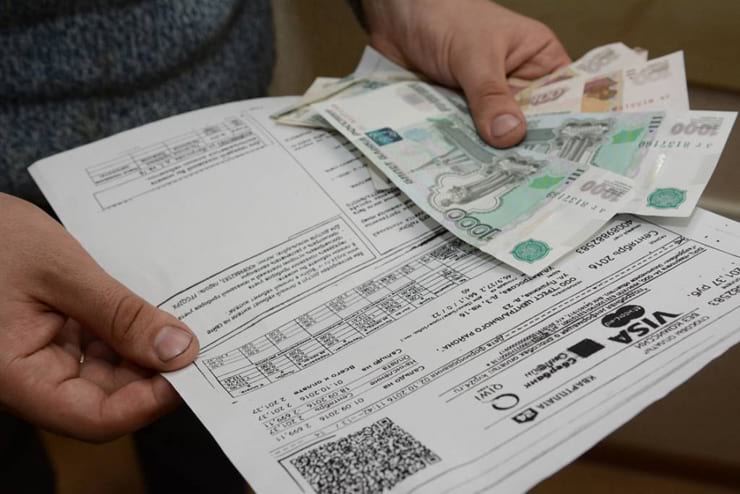
A fee is also charged for wastewater disposal. In this case, the invoice is issued by the management company.
Energy supply

Who do we pay?
Electricity supplier – ESKK LLC.
What are we paying for?
For the joys of civilization - from the light bulb on the ceiling to the computer on which you are reading this article. Electricity supply means wires, substations, more wires, aerial platforms, more wires... in general, a huge enterprise and hundreds of workers.
How much do we pay?
Here, too, you don’t have to overload yourself with calculations. You may not even know what a kilowatt is. The main thing is to know the tariff. In Kemerovo there are two of them - 1.92 rubles for apartments with an electric stove, and 2.74 rubles for apartments with a gas stove.
Judging by our “payment” we can conclude that the stove in the house is electric and the owners spend electricity sparingly. The standard per person is 100 kilowatts per month. The residents spent exactly 200 - they met exactly the same amount. However, if you slightly exceed the norm, then it’s okay too - the price per kilowatt will not change in any case.
200 x 1.92 = 384 rubles – our monthly payment for electricity.
In the case of electricity supply, payment for common household needs is no longer a formality. Entrances, basement, attic, courtyard - all this needs to be illuminated, and most houses also have elevators. The payment for one-room service is calculated according to the common house meter. The balance that is not covered by apartment payments is the cost of single living expenses. This amount is divided by the number of apartments. In our case, it turns out - 40.506 kilowatts per month. We multiply by 1.92, we get a payment for ODN for electricity in the amount of 77.77 rubles.
Line 10
Decoding of utility bills for housing and communal services, which is included in the rent receipt
It should be noted that there is no single form of receipt for housing and communal services that is mandatory for everyone. In different regions, cities, even houses, the management and supply of utility resources occurs differently. Therefore, the payment card may differ in appearance, shape, and color. It may consist of two parts: a notice and a receipt, or it may take the form of a single document.
What is included in the ODN according to current legislation? In fact, we are talking about the costs of maintaining the common property of the house. And it includes cleaning of entrances, their lighting and heating, elevator maintenance and other measures to maintain its normal condition.
Electromagnetic locks

Who do we pay?
The intercom technical center - in our case it is TCD Digital-Kemerovo LLC.
What are we paying for?
For relative safety, cleanliness and order in the entrance. For complete peace of mind, one castle is still not enough - here you need to chip in for the concierge. For your money, the company is obliged to maintain the lock and, in general, the entire front door in good condition.
How much do we pay?
Depends on the agreement with the company. By the way, it won’t hurt to have a copy of this document on hand. “Tsifral”, for example, asks for 44 rubles per month. All. No calculations.
Line 11

